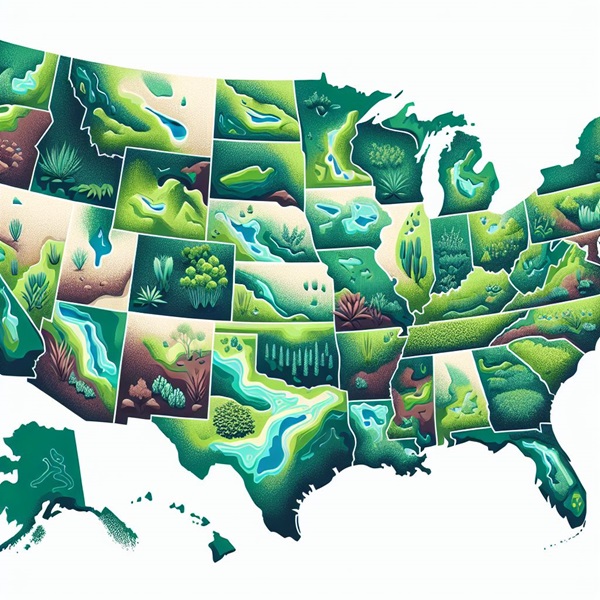
Article-at-a-Glance
- Exploring the environmental impact and water savings of xeriscaping.
- Identifying states that offer incentives for xeriscaping to encourage sustainable landscaping.
- Navigating the legal landscape: How state laws and HOA regulations affect xeriscaping.
- Steps to take advantage of xeriscaping programs and maximize your property’s eco-potential.
Your Gateway to a Greener Landscape: Xeriscaping Incentives
Imagine stepping into your garden and being greeted by a vibrant tapestry of native plants, each selected for its natural resilience and beauty. This is the heart of xeriscaping, a landscaping philosophy that champions sustainability and harmonizes with the local environment. But beyond the aesthetic appeal, xeriscaping offers tangible financial benefits that you, as an eco-conscious homeowner, should be excited about.
Spotlight on Key Xeriscaping Benefits
Xeriscaping isn’t just about planting drought-resistant plants; it’s a comprehensive approach to creating landscapes that require minimal water, maintenance, and resources. Most importantly, this method reduces your water bill and contributes to conserving our precious water supply. Because xeriscaping aligns with the growing need for water conservation, many states now offer incentives to encourage homeowners to adopt this eco-friendly practice.
Here’s why you should consider xeriscaping:
- Lower water usage translates to significant savings on your utility bills.
- Reduced maintenance frees up your time and cuts down on gardening costs.
- By opting for plants that thrive in your climate, you contribute to the health of your local ecosystem.
What Makes a State Xeriscaping-Friendly?
A xeriscaping-friendly state is one that recognizes the importance of sustainable landscaping practices and actively promotes them through various incentives. These may include rebates for removing water-intensive lawns, grants for installing water-efficient irrigation systems, or even offering free workshops on xeriscaping techniques. States with such programs understand that the long-term benefits of xeriscaping extend far beyond individual properties to the community and the environment at large.
Discovering Grants and Rebates
Finding the right grants and rebates for xeriscaping can feel like a treasure hunt. But with a little research and persistence, you can uncover some fantastic opportunities to financially support your transition to a more sustainable landscape. Start by checking with your local water authority or environmental agency, as they often have up-to-date information on available incentives.
For example, the Southern Nevada Water Authority offers rebates for homeowners who replace their turf with desert landscaping. This program has been instrumental in saving over 176 billion gallons of water since 1999.
These rebates can be substantial, covering a portion of the costs associated with xeriscaping, such as purchasing native plants or installing efficient irrigation systems. Therefore, it’s worth taking the time to understand what’s available in your state and how you can apply.
State Legislation Impacting Xeriscaping
Before you dive into transforming your yard, it’s crucial to understand the legal landscape. Some states have passed legislation that encourages xeriscaping by protecting homeowners’ rights to implement water-wise landscaping, despite what traditional homeowner association (HOA) covenants might say. For instance, states like California have laws that prevent HOAs from penalizing homeowners for converting to drought-tolerant landscaping.
HOA Guidelines and Xeriscaping Rights
HOAs are known for their strict landscaping rules, but that’s changing. More HOAs are getting on board with xeriscaping due to state laws and increased awareness of environmental issues. If you’re living in an HOA community, check your state’s laws and your HOA’s guidelines. Often, you’ll find that you have the right to xeriscape your property. Communicate your plans with your HOA and work together to find a solution that benefits everyone.
Tapping into Xeriscaping-Friendly Programs
Many states offer programs designed to support xeriscaping. These can range from rebates for specific xeriscaping projects to free resources like xeriscaping design templates or workshops hosted by local gardening experts. To tap into these programs, reach out to your local water conservation office or cooperative extension service.
Remember, these programs aren’t just about saving money; they’re about building a community that values sustainability. By participating, you’re not only transforming your own yard but also contributing to a larger movement towards water conservation and environmental stewardship.
Take, for example, the city of Austin, Texas, which offers a rebate of up to $1.50 per square foot of grass removed and replaced with native plants. They also provide a free landscape design service to help homeowners plan their new xeriscape gardens.
Such initiatives make it easier for homeowners to take the leap into xeriscaping, offering both financial support and expert guidance.
Residential Programs: Transforming Your Home’s Landscape
For individual homeowners, residential xeriscaping programs can make a world of difference. These programs often provide detailed instructions on how to replace water-thirsty lawns with drought-resistant plants, and may even offer financial incentives for each square foot of turf replaced. By taking advantage of these programs, you can significantly reduce your landscape’s water needs and maintenance costs while contributing to your community’s sustainability goals.
Commercial and Community Initiatives for Xeriscaping
It’s not just individual homeowners who can benefit from xeriscaping incentives. Commercial properties, homeowner associations, and community groups can also take part in initiatives that promote water-wise landscaping. These programs might include larger rebates for extensive xeriscaping projects or partnerships with local businesses that specialize in sustainable landscaping. By joining forces, communities can create a significant impact on water conservation efforts.
Mastering the Art of Xeriscaping
Xeriscaping is both an art and a science. It requires an understanding of your local climate, soil conditions, and native plant species. To master xeriscaping, start by researching plants that are indigenous to your area. These plants will naturally thrive in your climate, requiring less water and maintenance than non-native species.
The Basic Principles of Xeriscaping
The foundation of xeriscaping is built on seven basic principles: planning and design, soil analysis and improvement, appropriate plant selection, practical turf areas, efficient irrigation, use of mulches, and regular maintenance. By following these principles, you create a landscape that conserves water, is easy to maintain, and looks beautiful year-round.
To begin, draw up a plan that zones your yard based on the amount of sunlight, shade, and wind it receives. This will help you select the right plants for each area. Next, improve your soil to ensure it can retain moisture and provide nutrients to your plants. Choose a variety of plants that offer color and texture, and group them according to their water needs to maximize irrigation efficiency.
Designing Your Ideal Xeriscape: A Step-by-Step Approach
Designing a xeriscape doesn’t have to be overwhelming. Start with a vision of how you want your garden to look and function. Then, take it step by step:
- Assess your current landscape and decide which areas can be converted.
- Research plants that are suitable for your region and your yard’s conditions.
- Sketch a rough design, keeping in mind the mature size of plants and their water needs.
- Begin with a small area to gain confidence before tackling larger projects.
By breaking the process down into manageable steps, you’ll find that creating a xeriscape is a rewarding and achievable project.
Gearing Up for Ecological Change
As you prepare to embark on your xeriscaping journey, it’s important to arm yourself with the right tools and knowledge. Invest in a good set of gardening tools designed for xeriscaping, such as drip irrigation systems and mulch spreaders. Additionally, educate yourself on the best practices for maintaining your xeriscape to ensure its longevity and success.
Besides that, consider the long-term ecological change you’re contributing to. Xeriscaping is more than just a landscaping trend; it’s a commitment to a more sustainable way of living that respects our natural resources.
Accessing the Right Tools and Resources
There are plenty of resources available to help you with your xeriscaping project. Many local nurseries offer classes on xeriscaping, and there are countless books and online resources dedicated to the topic. Some states even provide free xeriscaping kits that include plans, plant lists, and tips for efficient watering.
Building a Network of Xeriscaping Advocates and Experts
Finally, don’t go it alone. Connect with a network of xeriscaping advocates and experts who can offer advice and support. Join local gardening clubs, attend workshops, and participate in online forums. Sharing experiences and learning from others can be incredibly valuable as you transform your landscape into a sustainable oasis.
Remember, every step you take towards xeriscaping is a step towards a more sustainable future. With the right approach and resources, you can create a stunning landscape that saves water, supports local ecosystems, and serves as an inspiration to others in your community.

FAQs
What Is the Difference Between Zero-Scaping and Xeriscaping?
It’s easy to confuse the two, but they’re quite different. Zero-scaping is often a term used to describe a landscape with little to no vegetation – think gravel and rocks with maybe a few hardy plants. Xeriscaping, on the other hand, is about creating a diverse, sustainable landscape that uses water efficiently. It involves selecting a variety of plants that are well-adapted to the local climate and require minimal watering once established.
Can I Implement Xeriscaping in a Cooler Climate?
Definitely! Xeriscaping isn’t just for hot, arid regions. It’s about choosing plants that are appropriate for your climate, whatever it may be. In cooler climates, you’ll focus on plants that can handle the cold and still don’t need much water. You might be surprised by the variety of beautiful, water-wise plants available for cooler regions.
How Do Xeriscaping Rebates Impact My Taxes?
Rebates can sometimes be considered taxable income, so it’s important to check with a tax professional. However, many rebates are structured as discounts on products or services and may not be taxable. Keep all your paperwork and consult with a tax advisor to understand how the rebate may affect your tax situation.
What Are the Long-Term Cost Benefits of Xeriscaping?
Xeriscaping can lead to substantial cost savings over time. By reducing your water usage, you’ll see lower utility bills. You’ll also spend less on maintenance, fertilizers, and pesticides since native plants tend to be hardier and require fewer inputs. Plus, a well-designed xeriscape can increase your property value. It’s a smart investment that pays off both financially and environmentally.
Are There Xeriscaping Options for Renters?
Renters can also embrace xeriscaping principles, even if they can’t make permanent changes to the landscape. Consider container gardening with drought-resistant plants, or discuss with your landlord the possibility of making xeriscape improvements in exchange for a longer lease or other benefits. It never hurts to propose a plan that could save water and money!



